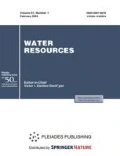Abstract
The issues related to the assessment of the hydro morphological status of urban rivers in order to identify the revitalisation actions possible to be carried out, has been acquiring significant importance in recent years. The revitalisation of urban rivers and the waterfront urban space must be preceded by an assessment and determination of the direction of revitalisation measures necessary to be implemented. Most of the methods used worldwide to assess the hydro morphological condition of the river do not include the element of planning revitalization activities. Meanwhile, there is a close relationship between the morphological conditions of the river and its corridor, and the range of necessary and feasible activities aimed at recreating some of the natural features of the river, with the simultaneous increase in the possibility of using the adjacent area as a safe public space. The existing methods used to identify places where revitalisation works are possible, omit many morphological elements of the rivers under analysis. This makes impossible to monitor their morphological status later and assess the effectiveness of the implemented works. The paper presents the results of the Unified Stream Assessment (USA) method of the urban river Kłodnica, located in Upper Silesia, which is the area with the largest degree of urbanisation and industrialisation in Poland. The conducted assessment allowed to determine possible revitalization activities, indicated significant limitations as well as the need to modify the USA method. Results of the study revealed that proposed revitalisation actions based on the USA assessment should take into account the nature of the whole watershed and not just river corridor. The modification of USA method results proper development of urban river assessment and revitalisation process.





Similar content being viewed by others
REFERENCES
Bain, D.J., Copeland, E.M., Divers, M.T., Hecht, M., Hopkins, K.G., Hynicka, J., Koryak, M., Kostalos, M., Brown, L., Elliott, E.M., Fedor, J., Gregorich, M., Porter, B., Smith, B., Tracey, C., and Zak, M., Characterizing a major urban river restoration project: Nine Mile Run (Pittsburgh, Pennsylvania, USA), J. Am. Water Resour. Assoc., 2014, vol. 50, no. 6.
Bernhardt, E.S. and Palmer, M.A., Restoring rivers in an urbanizing world, Freshwater Biol., 2007, vol. 52, pp. 738–751.
Bruttomesso, R., The strategic role of the waterfront in urban redevelopment of cities on water, in Large scale urban development, Lorens, P., Ed., Politechnika Gdańska, 2001.
Doyle, M. and Shields, D., Compensatory mitigation for rivers under the Clean Water Act: Reassessing science and redirecting policy, J. Am. Water Resour. Assoc., 2012, vol. 48, pp. 494–509.
Doyle, M., Shields, D., Boyd, K.F., Skidmore, P.B., and Dominic, D., Channel-forming discharge selection in river restoration design, J. Hydraul. Eng., 2007, vol. 133, no. 7, pp. 831–837.
Gurnell, A., Lee, M., and Souch, C., Urban Rivers: Hydrology, Geomorphology, Ecology and Opportunities for Change, Geogr. Compass, 2007, vol. 1, no. 5, pp. 1118–1137.
Kenney, M.A., Wilcock, P.R., Hobbs, B.F., Flores, N.E., and Martinez, D.C., Is urban river restoration worth it?, J. Am. Water Resour. Assoc., 2012, vol. 48, no. 3.
Kitchell, A., Schueler, T., Urban Subwatershed Restoration Manual 10 Unified River Assessment: a user’s manual, CWP, 2005.
Łabaj, P. and Hamerla, A., Ocena warunków hydromorfologicznych rzek w zlewniach zurbanizowanych metodą River Habitat Survey, Prace Naukowe GIG Górnictwo i Środowisko, 2012, vol. 4.
Muszyńska-Jeleszyńska, D., Tereny nadrzeczne w aspekcie rozwoju i rewitalizacji miast, J. Health Sci., 2013, vol. 3, no. 14, pp. 99–107.
Smith, R.F., Hawley, R.J., Neale, M.W., Vietz, G.J., Diaz-Pascacio, E., Herrmann, J., Lovel, A.C., Prescott, C., Rios-Touma, B., Smith, B., and Utz, R.M., Urban river renovation: incorporating societal objectives to achieve ecological improvements, Freshwater Sci., 2016, vol. 35, no. 1, pp. 364–379.
Walsh, C.J., Fletcher, T.D., and Ladson, A.R., River restoration in urban catchments through redesigning stromwater systems: Looking to the catchment to save the river, J. North Am. Benthol. Society, 2005, vol. 24, pp. 690–705.
Wohl, E., Lane, S.N., Wilcox, A.C., The science and practice of river restoration, AGU Publications, Water Resour. Res., 2015, vol. 51, no. 8, pp. 5974–5997.https://doi.org/10.1002/2014/WR016874
ACKNOWLEDGMENTS
This study was partially supported by the grant no 11311217-343 as a part of statutory research founded by Polish Ministry of Science and High Education.
Author information
Authors and Affiliations
Corresponding authors
Rights and permissions
About this article
Cite this article
Łabaj Paweł, Małgorzata, W., Ewa, J. et al. Application of the Unified Stream Assessment Method to Determine the Direction of Revitalization of Heavily Transformed Urban Rivers. Water Resour 47, 521–529 (2020). https://doi.org/10.1134/S0097807820040120
Received:
Revised:
Accepted:
Published:
Issue Date:
DOI: https://doi.org/10.1134/S0097807820040120




